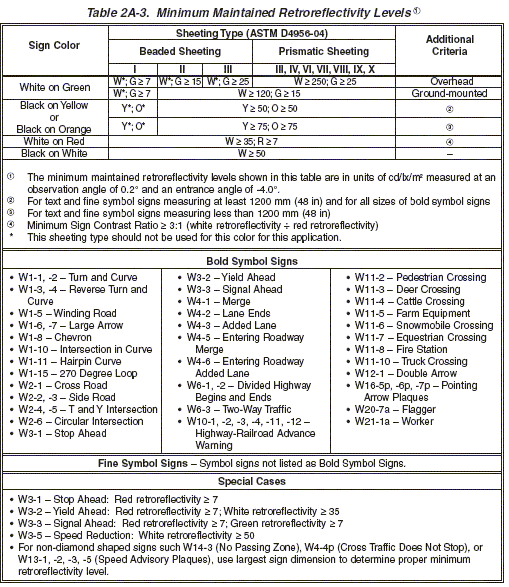FHWA Standards

MUTCD minimums establish a means to improve the nighttime visibility of traffic signs to promote safety, enhance traffic operations and facilitate comfort for drivers of all ages and abilities. (1)
MUTCD standards for sign retroreflectivity or illumination have remained essentially unchanged for 45 years.(2) In the 1980's, the FHWA began nighttime sign visibility research and in 1993 Congress directed the FHWA to revise the MUTCD to include minimum levels.(12) That ruling has produced minimums for critical traffic signs with a table of specific requirements and implementation (referenced below).
FHWA Standard
One or more of the following assessment or management methods shall be used to maintain sign retroreflectivity above the minimum levels:
- Visual nighttime inspections
- Measured retroreflectivity
- Expected life
- Blanket replacement
- Control signs
See Getting Started for more information on these assessment/management methods.
Minimum retroreflectivity standards also apply to Private Roads
- Effective January 17, 2007, MUTCD regulations apply to "all roads open to public travel."
- Includes toll roads and roads within shopping centers, parking lots, airports, sports arenas, and other similar business and recreation facilities that are privately owned but where the public is allowed to travel without access restrictions.
- Owners or parties responsible for such private roads have two years from the date of the ruling (January 17, 2007) to bring traffic control devices into compliance with the MUTCD and other applicable State Manuals.

Source:(13)
- Determines the ratio of retroreflective contrast and sign size ("Conditions"). For example, white-on-red retroreflective signs such as Stop or Do Not Enter signs require a 3:1 (white:red) contrast ratio. When the contrast ratio is lower, the sign should be replaced.
- Indicates with an "*" where ASTM I (engineer grade) should not be used such as black on orange/yellow signs. Sheeting material for white-on-red signs should not fall below an RA (coefficient of retroreflection) of 35 measured in candelas per lux per meter squared. (For more information on these calculations, see the "Retroreflective Science" tab)
- Provides some exclusions for signs such as Parking, Walking, Adopt-A-Highway, Bikeway, etc.)
1 Morse, K., Proposed minimum requirements for maintaining traffic sign retroreflectivity, Illinois Interchange, Fall/Winter 2004
2 Night Lights…lighting the way (Answering Your Questions about Traffic Sign Retroreflectivity), U.S. Department of Transportation, Federal Highway Administration
12 Texas Transportation Researcher, TTI, Vol 48, No. 1, 2004
13.Notice of proposed amendment: maintaining traffic sign retroreflectivity; FHWA Office of Safety Retroreflectivity Team PowerPoint
Back To Top
